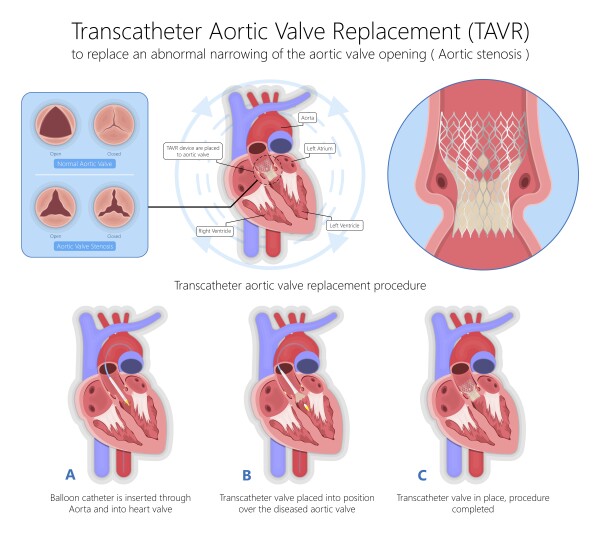
POSTED BY
James Gillman
Innovation in Transcatheter Mitral and Tricuspid Therapies
Until recently, highly invasive open-heart surgery was the only reliable solution for most structural heart disease conditions. Over the last few years, however, there have been several important new developments in mitral and tricuspid treatments.
Transcatheter aortic valve replacement (TAVR) has now become an accepted, trusted and highly effective element in the management of aortic stenosis. It is the reliable and safe choice now, even for patients who would be in low-risk categories for surgery.
This success has led to a major trend in the global market with a shift towards minimally invasive procedures, with refined products from market leaders like Edwards Lifesciences, Medtronic, Boston Scientific and Abbott.
These procedures improve patient health outcomes and reduce procedure complexity. The market is already over £5 billion and is set to grow substantially in 2021 and beyond, with innovative devices and procedures coming on stream to meet growing demand from an aging patient population and the expansion of access to healthcare in emerging markets.
The next big developments look to be coming from similar products and procedures designed to treat structural issues with the more challenging mitral and tricuspid valves.
The prospect of advancing these therapies is attracting investment and interest from innovative researchers and medical appliance designers.
Mitral valve therapies are having their day.
“In the mitral arena, there’s a lot going on,” says interventional cardiologist Jon Resar, medical director of Johns Hopkins’ Structural Heart Disease Program. “This is the new frontier. We’ve conquered the aortic valve, and now it’s time to move on to the mitral valve.”
Now, in addition to open surgical approaches to mitral valve repair or replacement, many surgeons are embracing new, minimally invasive, transcatheter options for mitral and tricuspid valve replacement and repair.

Repair
Patients with mitral valve regurgitation can now opt for transcatheter mitral valve repair (TMVR) using systems such as MitraClip from Abbott.
In a minimally invasive procedure, a cardiac specialist passes a catheter up to the heart through a blood vessel in the groin or shoulder. Guided by echocardiogram, this allows the placing of small device – the MitraClip - that clips the anterior and posterior leaflets of the mitral valve together, reducing the leaking of the valve. Echocardiographic guidance allows experts to verify the results of the procedure as they perform it. Patients stay in the hospital for one night and have a follow-up echocardiogram the next day to make sure the clip is working.
Abbott have now developed a new generation of TriClip, the first transcatheter device designed to stem leaks in the heart's tricuspid valve.
The tricuspid is regarded as presenting particular anatomical challenges compared to the mitral valve – it has a set of three leaflets rather than two. In the past, this has meant that patients with tricuspid valve issues have had fewer treatment options.
The company’s top-selling MitraClip helped treat mitral regurgitation, or the backflow of blood through the valve with each heartbeat. One of the most common valve diseases, regurgitation ultimately forces the heart to work harder than it should. The device clips the two leaflets together at the center, creating two smaller openings that can form a tighter seal.
The upgraded TriClip works in the same way, but allows clinicians to tailor the procedure to each patient’s unique valve using a range of four sizes to hold together a portion of its flaps. It also includes a new, steerable delivery system that lets surgeons independently grasp leaflets before fastening.
Describing tricuspid regurgitation as “the most undertreated valve issue,” the senior VP of Abbott’s structural heart business, Mike Dale, said in a statement that the TriClip aims to offer more options for the debilitating condition, which when left untreated can lead to atrial fibrillation, heart failure and death.
The condition is typically found in older people with other health problems that may make open-heart surgery too risky. For those patients, transcatheter approaches like the TriClip’s could be a preferable option.
Replacement
Patients with severe symptomatic mitral regurgitation can receive a replacement prosthetic valve that completely eliminates regurgitation.
Many transcatheter replacement therapies for mitral and tricuspid valves are transapical – inserting the new, synthetic valves through keyhole surgeries through the ribs. However, there is a growing movement towards transcatheter delivery through the artery – although the structure, size and position of the mitral and tricuspid valves may preclude this.
Mitral
The mitral valve is a more complex dynamic and difficult to access structure than the aortic valve. Transcatheter mitral valve replacement (TMVR) has to allow for its noncircular shape, irregular leaflet geography and the presence of the subvalvular apparatus. The use of 3D computed tomography is vital in evaluating patient eligibility too.
Despite rapid advances, there are still considerable procedure‐related complications to contend with and midterm mortalities have remained high.
It is thought that an improvement in patient selection, new imaging technology, and an increased use of transfemoral–transeptal delivery may lead to better ourtcomes.
Tricuspid
Transcatheter tricuspid valve replacement (TTVR) has the potential to fulfil a significant unmet clinical need. There are two main types of TTVR - orthotopic, where the valve is deployed at the tricuspid valve annulus, and heterotopic, where it is deployed in one or both vena cavae.
The first in-human trials have been successfully carried out with feasibility studies ongoing in both the United States and across Europe for devices such as Evoque, Cardiovalve, Intrepid, and TricValve.
As with the development of TAVR, outcomes will only improve as each generation of device addresses the flaws in its predecessor, and as operators gain more experience performing the procedure.
In conclusion
There is a significant degree of investment in the field of transcatheter valve repair and replacement. There is a lot still to learn about optimal device and patient selection, as well as developments in delivery, guidance and growing practitioner specialisms. Transcatheter valve therapies are set to attract investment, expand into new territories and demographies, and continue to offer real optimism for patients suffering from chronic heart valve degeneration who would otherwise have limited access to more risky treatment options.
Posted by James Gillman, Associate Director - MedTech
https://www.linkedin.com/in/jamesgillman/
Sources:
- Mitral Valve Replacement: A Systematic Review David del Val et al
- https://idataresearch.com/product/cardiac-surgery-market/?gclid=Cj0KCQjwwY-LBhD6ARIsACvT72PZ0lszgPePkxGadOwDp9AlOvwTUt0-atAftX4QD2guCYQJK1GyoeoaAvPpEALw_wcB
- Looking to the future of mitral valve replacement | European Heart Journal | Oxford Academic (oup.com)
- https://www.annalscts.com/article/view/16556/html
- https://www.frontiersin.org/articles/10.3389/fcvm.2021.619558/full



